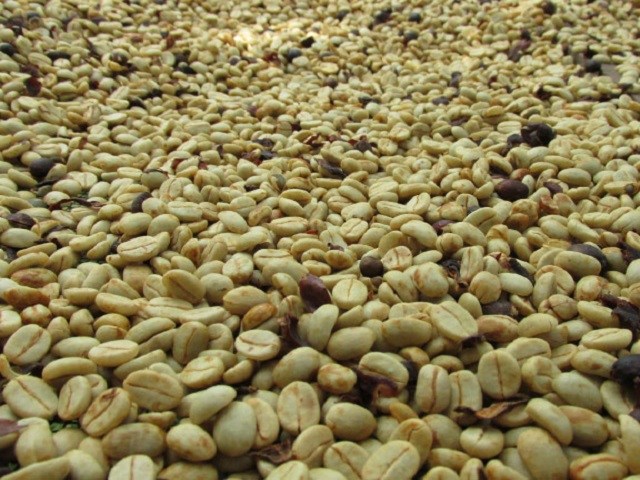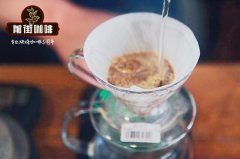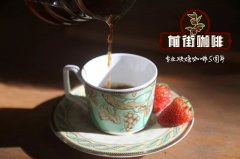To what extent do you grind the beans of Pacamara black honey coffee on the Manor of San Leticia in El Salvador?

Professional coffee knowledge exchange more coffee bean information please follow the coffee workshop (Wechat official account cafe_style)
El Salvador San Leticia Manor Pacamara Coffee Black Honey
Country of origin: El Salvador (EL SALVADOR)
Producing area Manor: Saint Leticia Manor (Santa Letcia Estate)
Coffee variety: Pacama (Pacamara)
Growth altitude: 1620-1730 m
Treatment: black honey treatment, sun drying
Raw bean grade: SHG

Introduction to the information story of the Manor of St. Leticia:
Introduction to the manor
The bean comes from El Salvador's San Leticia Manor, near the town of Apaneca in Ahuachapan province, and is managed by third-generation curry farmer Ricardo Valdivieso and his family. In 1870, RicardoValdivieso's grandfather bought the land and named it after his wife, Leticia.
As the origin of Pacamara in El Salvador, there is no shortage of excellent coffee estates. The Chateau San Leticia (Santa Letcia) is located in the Apaneca volcanic area west of El Salvador, with an average elevation of 1400 meters. The Pacamara produced here is honey-treated and fruity, but it has a very high balance of sour and bitterness, soft and long taste, heavy feeling and excellent sweetness.

Finca Santa Leticia was founded in 1870. Its founder, Francisco Menendez, is an important figure in the history of El Salvador. He not only made great contributions to the education system of Giza, but also became president in 1886. During his reign, he drafted a constitution to lead the country to freedom and democracy. After his death on June 22nd, 1890, the people of the country commemorated this day every year as teacher's Day. Today, the estate is inherited by the descendants of his family.
Located in the Apaneca volcanic area of western El Salvador and on the Central American ecological corridor stretching from Mexico to Panama, the San Leticia Manor covers an area of nearly 100 hectares. Shade planting (shade-grown) is very important to the conservation of local biodiversity. According to statistics, the manor inhabits more than 120 species of migratory birds and 259 species of insects, which can produce 2500 kilograms of fresh oxygen for the earth every day.

Introduction of Pacamara coffee bean varieties:
Pacamara is a hybrid cultivated in El Salvador in 1958. Its parents are Pacas and Maragogype. They have the advantages of both, but they are better than blue. Pure and soft, mellow and smooth, acidity lively, full flavor, long finish, amazing. With the excellent taste of Pacas, raw bean granules also inherit the large size of Maragogipe, the bean body is at least 70% of that of beans, 100% more than 17 mesh, 100% more than 18 mesh, 90% above 18 mesh, average bean length 1.03cm, average bean width 0.71cm, thickness 0.37cm, bean shape plump and round. Pakamara is a combination of the first four letters of his "parents": Paca+mara=Pacamara.
Pacamara stunned people on COE in El Salvador in 2005. In the top ten, Pakamara bean seed occupies the second, fifth, sixth and seventh place!
In 2007, the Pacamara breed won the COE championships of Guatemala and El Salvador. Since then, Pakamara has been out of control on the road of winning the award, has occupied the forefront of the list of major events for a long time, and is known as a rookie variety as famous as Rosa in the world.
On COE in Guatemala alone, Pakamara won the title in seven of those 10 years in 2008 / 2017.
Due to the unnatural performance of Pacamara on the field, in 2017, the BOP (Best of Panama) international competition group decided to compete as a separate group.
However, Rao still has some disadvantages: Pacamara has high requirements for soil and water, climate, environment and altitude, and its yield is not high and its resistance to leaf rust is low, so its planting popularization rate is not high.
Today, although Pacamara is no longer particularly rare, it is still not a very common bean in the market. In particular, Pakamara is best produced in Guatemala and El Salvador, with a large number of international pursuers, so it is even more rare for those who can reach the country.

Introduction to honey treatment:
What is honey treatment?
Honey treatment originated in Costa rica. to put it simply, honey treatment is a way to treat coffee with pectin and endocarp after the peel and flesh are removed. The key to distinguish between different honey treatments lies in the choice of the remaining pectin: retaining the proportion of pectin and drying speed and method.
Yellow honey (White Honey): about 40% of the pectin is removed; the drying method requires the most direct heat absorption, receives the most light drying, and lasts for about 8 days to reach a stable water content.
Red honey (Red Honey): about 25% of the pectin is removed; it dries longer than yellow honey, and reduces the time spent in direct sunlight, even in shading sheds, lasting about 12 days.
Black honey (Black Honey): hardly removes pectin; dries for the longest time, lasting at least 2 weeks, using a covering to avoid too strong sunlight, prevent drying too fast, and make sugar conversion more fully.

Baking suggestions / Analysis:
The variety of this coffee is giant bean [Pacamara] with relatively large granules and high density, and the newly produced kidney beans have high moisture content. The heat absorption is relatively slow in the baking process, and the Mena reaction process is also relatively fast. The yellowing point is about 5 minutes. In the first baking, you can try to lower the bean temperature slightly, for example, the bean temperature is 200 degrees, and the firepower is also relatively increased. In the baking process, gradually adjust the firepower as needed: adjust the firepower after the beans enter the yellowing point to prolong the dehydration time, so that the giant beans can be fully dehydrated. Before an explosion after dehydration, you can properly maintain medium heat or slightly increase the firepower, accelerate the Mena reaction time, and ensure the pressure before the explosion; the precursor of an explosion needs to adjust the firepower properly to avoid bean watch burns. Under this method of operation, the dehydration time of coffee is relatively prolonged, with a heating rate of 6-8 degrees every 30 seconds, but it can also maintain a normal explosion between 8 and a half minutes and 9 and a half minutes, preserving more flower and fruit aroma and keeping clean and bright acidity. It is usually recommended to drop beans between the dense back section of an explosion and the end of an explosion, and bake about moderately.
Cup test flavor description:
Flavor features: dried longan, soft fruity, sweet, mellow, clean, very rich taste
Cooking analysis:
Today, we introduce the common method of making Pacamara coffee in front street: V60 three-stage water injection method.
Extract by stages, pour all the cooking water into three stages.
Suitable for light, medium and medium roasted coffee beans
Use filter cup V60 cup
Increasing the steaming time or water cut-off times can improve the rich taste of the coffee.
Segmented extraction method of three-stage water injection
Advantages: it is richer than the one-knife flow, and can clarify the flavor of the front, middle and back of the coffee. The method is to increase the amount of water injection each time after steaming, usually when the coffee liquid is about to drop to the surface of the powder layer, and use small, medium and large water flow to do three-stage extraction.
Disadvantages: there will be relatively high requirements for the flow rate and flow rate of water.

Qianjie [suggestion of Pacamara Coffee hand punching parameters]
Brewing with V60 filter cup can improve the layering of hand flavor and make it richer and cleaner to drink; the bright aroma of Pacamara variety can be fully displayed.
15g powder, water temperature 89-90 degrees, grinding BG 5R (64% pass rate of Chinese standard 20 sieve), water powder ratio close to 1:15-16
Technique: 27g water steaming, steaming time for 30s. The hot water in the hand flushing pot draws a circle clockwise with the center of the filter cup in the middle of the filter cup, starts the time when brewing, injects water to 27g, then stops the injection and waits for 30 seconds to inject water for the first time.
When the first water injection is the same as before, the speed can be slowed down slightly, speed up a little when you go around the outer circle, cut off the water at about 1:15 seconds, and then inject water again when the liquid level drops 1 inch 3. The second water injection is concentrated on the central water injection. The water flow should not rush to the place where the coffee powder is connected with the filter paper, so as not to produce channel effect. Finish the extraction at about 2:05 seconds, and the longer the time is, the longer the extraction can be done. The astringent and rough taste will increase.
Segment: 30-125-230g
END
Important Notice :
前街咖啡 FrontStreet Coffee has moved to new addredd:
FrontStreet Coffee Address: 315,Donghua East Road,GuangZhou
Tel:020 38364473
- Prev

What is the ratio of gouache to powdered coffee made by the Pacamara hand in the Mamamina Manor in Nicaragua?
Professional coffee knowledge exchange more coffee bean information please follow the coffee workshop (Wechat official account cafe_style) Nicaragua Mamana family Mamana Manor Pacamara species 19 sifted sun treatment method Nicaragua Mierisch Family Finca Mamamina Pacamara Natural Mamana Manor Information Story introduction: this Nicaraguan Palmer
- Next

Panamanian Hartman Manor Elephant Bean Pacamara Wine Flavor Coffee hand-brewing parameters sharing
Professional coffee knowledge exchange more coffee bean information please follow the coffee workshop (Wechat official account cafe_style) Panama Finca Hartmann Pacamara Winey Panamanian Hartman Manor Pacamara seed wine / sun treatment-country: Panamanian production area: Chiriqui altitude
Related
- Detailed explanation of Jadeite planting Land in Panamanian Jadeite Manor introduction to the grading system of Jadeite competitive bidding, Red bid, Green bid and Rose Summer
- Story of Coffee planting in Brenka region of Costa Rica Stonehenge Manor anaerobic heavy honey treatment of flavor mouth
- What's on the barrel of Blue Mountain Coffee beans?
- Can American coffee also pull flowers? How to use hot American style to pull out a good-looking pattern?
- Can you make a cold extract with coffee beans? What is the right proportion for cold-extracted coffee formula?
- Indonesian PWN Gold Mandrine Coffee Origin Features Flavor How to Chong? Mandolin coffee is American.
- A brief introduction to the flavor characteristics of Brazilian yellow bourbon coffee beans
- What is the effect of different water quality on the flavor of cold-extracted coffee? What kind of water is best for brewing coffee?
- Why do you think of Rose Summer whenever you mention Panamanian coffee?
- Introduction to the characteristics of authentic blue mountain coffee bean producing areas? What is the CIB Coffee Authority in Jamaica?

